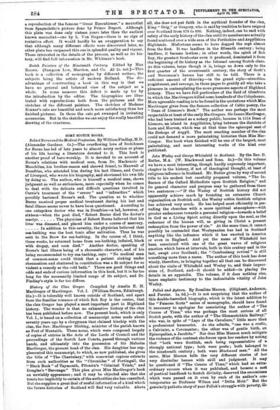History of the Clan Gregor. Compiled by Amelia E. M.
MacGregor of MacGregor. Vol. I. (William Brown, Edinburgh. 21s.)—It is tolerably well known outside of Scotland, and apart from the familiar romance of which Rob Roy is the centre, that the clan Gregor has played a most important part in Highland history. The wonder is that no exhaustive history of the clan has been published before now. The present book, which is only Vol. I., is based on a collection of manuscript notes made about seventy years ago by a clergyman that claimed kinship with the clan, the Rev. MacGregor Stirling, minister of the parish known as Port of Menteith. These notes, which were composed largely of copies of entries in the Acts of the Lords of Council and the proceedings of the Scotch Law Courts, passed through various hands, and ultimately into the possession of Sir Malcolm MacGregor, the present head of the clan. His daughter has sup- plemented this manuscript, to which, as now published, she gives the title of "The Chartulary," with somewhat copious extracts from such authorities as the " Chronicles " of Fortingall, the " Black Book" of Taymouth, Pitcairn's "Criminal Trials," and Douglas's "Baronage." This plan gives Miss MacGregor's book an unwieldy appearance ; and it may be objected also that she trusts too implicitly to certain of the authorities she has consulted. But she supplies a great deal of useful information of a kind which the future historian of Scotland will find very valuable. Above all, she does not put faith in the mythical founder of the clan, King" Grig," or Gregory, who is said by tradition to have reigned
over Scotland from 878 to 890. Nothing, indeed, can be said with safety of the early history of the clan until its members are actually found scattered over a wide area of the Perthshire and Argyllshire
Highlands. Misfortune seems to have dogged the sept almost from the first. It was landless in the fifteenth century ; being landless, it became lawless ; in other words, the spirit of Rob Roy, the greatest freebooter even it produced, dominated it from the beginning of its history as the Ishmael among Scotch clans. As this volume, large though it is, brings us down only to the first quarter of the seventeenth century, the story of Scott's and Stevenson's heroes has still to be told. There is a sufficient amount of thieving—in the grand style—atrocities, punishment, and revenge, in these pages to gratify all who take a pleasure in contemplating the more gruesome aspects of Highland history. Thus we have full particulars of the Raid of Glenfruin in which the Mac Gregors killed some hundreds of the Colquhouns. More agreeable reading is to be found in the quotations which Miss MacGregor gives from the famous collection of Celtic poetry, the "Dean of Lismore's Book." The author was perhaps the most respectable at least of the early MacGregors. Sir James MacGregor, who had been trained as a notary public, became in 1514 Dean of Lismore, an island in Argyllshire, lying between the districts of Lora and Aforven, which was at that time the episcopal seat of the Bishops of Argyll. The most exacting member of the clan could not demand a more painstaking historian than Miss Mac- Gregor. Her book when finished will be one of the largest, most painstaking, and most interesting works of the kind ever published.






















































 Previous page
Previous page